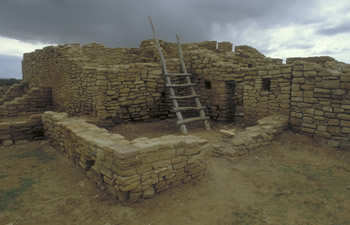 50 feet off Road G somewhere near Ismay Trading Post, Utah, an often empty slickrock parking lot ends with a sign that restricts motor vehicles in the Canyons of the Ancients National Monument.
50 feet off Road G somewhere near Ismay Trading Post, Utah, an often empty slickrock parking lot ends with a sign that restricts motor vehicles in the Canyons of the Ancients National Monument.
Small braids of footpaths rise gradually from the trailhead into the monument, toward juniper trees and cliff faces. The braided trails weave carelessly around juniper trees and patches of ground cactus, occasionally disappearing over slickrock sections.
Gradually the trails coalesce to an established route, somewhere just beyond the average distance that most passersby consider a reasonable stretch of their legs in their off-the-beaten drive through the Four Corners area.
As the scattered paths of that first mile of trail fade, small rock cairns marking the way over slickrock slabs begin to stand out boldly from the desert floor.
Shallow dry washes that rise mere inches from channel to floodplain become glaring landmarks of microriver systems on the sandy floor. The trail traces a bench entering the mouth of a large canyon. Feeling more confident moving over the desert terrain, a hiker raises his attention from the desert floor to the vast landscape.
A series of dramatic precipices separates the canyon floor from tiered benches progressively leading to the cliff face and canyon rim above. The canyon is deep and broad bottomed, with a small stream still trickling through its center hundreds of feet below.
Abandoning the broad bench for any of the numerous narrower side canyons leads to mysterious hideaways. Bending around a turn in one such side canyon a set of ruins can suddenly give a hiker pause. Often tucked up off the canyon floor under a rock overhang are small houses built of stone and mortar, remnants of the ancient settlers that once lived here. Seeing these ruins is a striking reminder of the people that farmed this desert country, built their structures, and painted their symbols on rock faces.
Although it is often disputed why the these people left their cliff dwellings, it is generally agreed that they did not vanish, but merged into the various pueblo peoples whose descendants still live in Arizona and New Mexico. For this reason they are properly referred to as Ancestral Puebloans, although Anasazi, a Navajo word, is also used.
Designated only six years ago this amazing resource is protected for us to enjoy thanks to a little known, but hugely important, piece of legislation called the Antiquities Act. This year marks the centennial of the Act.
Thanks to this forward-looking piece of legislation, the much older archeological sites of Canyons of the Ancients National Monument are our collective inheritance. So long as we treat these places with reverence they will remain for us to discover and learn from for generations to come.